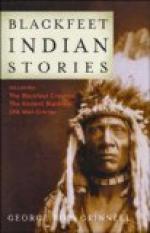In those days the people used to make holes in the walls of the fence about the enclosure into which they led the buffalo. They set snares over these holes, and when wolves and other animals crept through them so as to get into the pen and feed on the meat they were caught by the neck and killed, and the people used their skins for clothing.
One night all the wolves went down to the pen to get meat, and when they had come close to it, the man-wolf said to his brothers, “Stop here for a little while and I will go down and fix the places so that you will not be caught.” He went down to the pen and sprung all the snares, and then went back and called the wolves and the others—the coyotes, badgers, and kit-foxes—and they all went into the pen and feasted and took meat to carry home to their families. In the morning the people found the meat gone and all their snares sprung, and they were surprised and wondered how this could have happened. For many nights the nooses were pulled tight and the meat taken; but once when the wolves went there to eat they found only the meat of a lean and sickly bull. Then the man-wolf was angry, and he cried out like a wolf, “Bad-food-you-give-us-o-o-o! Bad-food-you-give-us-o-o-o-o!”
When the people heard this they said to one another, “Ah, it is a man-wolf who has done all this. We must catch him.” So they took down to the piskun[1] pemmican and nice back fat and placed it there, and many of them hid close by. After dark the wolves came, as was their custom, and when the man-wolf saw the good food, he ran to it and began to eat. Then the people rushed upon him from every side and caught him with ropes, and tied him and took him to a lodge, and when they had brought him inside to the light of the fire, at once they knew who it was. They said, “Why, this is the man who was lost.”
[Footnote 1: A
pen or enclosure, usually—among the
Blackfeet—at
the foot of a cliff, over which the buffalo
were induced to jump.
Pronounced p[)i]’sk[)u]n.]
“No,” said the man, “I was not lost. My wives tried to kill me. They dug a deep hole and I fell into it, and I was hurt so badly I could not get out; but the wolves took pity on me and helped me or I would have died there.”
When the people heard this they were angry, and they told the man to do something to punish these women.
“You say well,” he replied; “I give those women to the punishing society. They know what to do.”
After that night the two women were never seen again.
KUT-O-YIS’, THE BLOOD BOY
As the children whose ancestors came from Europe have stories about the heroes who killed wicked and cruel monsters—like Jack the Giant Killer, for example—so the Indian children hear stories about persons who had magic power and who went about the world destroying those who treated cruelly or killed the Indians of the camps. Such a hero was K[)u]t-o-y[)i]s’, and this is how he came to be alive and to travel about from place to place, helping the people and destroying their enemies.




